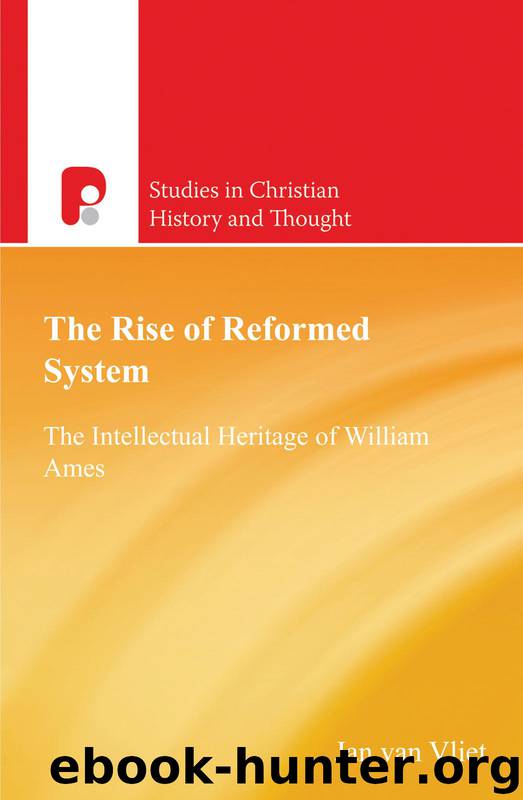The Rise of the Reformed System: The Intellectual Heritage of William Ames by Jan van Vliet

Author:Jan van Vliet
Language: eng
Format: mobi
Tags: Religion & Spirituality, Churches & Church Leadership, Christian Books & Bibles, Church History
Publisher: Paternoster
Published: 2014-09-10T22:00:00+00:00
* * *
1 W. Verboom, De Theologie van de Heidelbergse Catechismus. Twaalf Themas: De Context en de Latere Uitwerking (Zoetermeer: Boekencentrum, 1996), 15-25. The literature on the Heidelberg Catechism and its origins and intent is immense. I will not repeat that here. Suffice to say that the Catechism was composed by two individuals. One of these was Zacharias Ursinus, professor at the university in the city of Heidelberg in the Palatinate, during the Lutheran Reformation. The Calvinist, Frederick (III) the Elector (1515-76), had just succeeded Otto Henry to this post in 1559 and sought a manual of instruction that would teach a system of the Reformed faith in place of the then prevailing Augsburg Confession (1530, authored by Luther and Melanchthon). Along with Ursinus, Caspar Olevianus, a minister in Heidelberg and predecessor of Ursinus at the university, was the second individual commissioned to this task. The Catechism was adopted as one of the three Forms of Unity of the Dutch Reformed Church at the Synod of Dort (the others being the Belgic Confession (1561) and the Canons of Dort (161-819). See also: L.D. Bierma et al., An Introduction to the Heidelberg Catechism: Sources, History, and Theology, Texts and Studies in Reformation and Post-Reformation Thought, R.A. Muller, ed. (Grand Rapids: Baker, 2005). A particular strength of this excellent volume includes translations of the Smaller and Larger Catechisms of Zacharias Ursinus; H. Hoeksema, The Triple Knowledge: An Exposition of the Heidelberg Catechism 3 vols. (Grand Rapids: Reformed Free, 1970), 10-15; C. Buchanan, “Catechisms” NIDCC, 199-201; Caspar Olevianus, A Firm Foundation: An Aid to Interpreting the Heidelberg Catechism, L.D. Bierma, trans and ed. Texts and Studies in Reformation and Post-Reformation Thought, R.A. Muller, ed. (Grand Rapids: Baker, 1995), xiii-xlii; hereafter “Olevianus by Bierma,” Firm Foundation; and B. Thompson et al., Essays on the Heidelberg Catechism (Philadelphia: United Church, 1963).
2 Verboom, Heidelbergse Catechismus, 16-17. This is, in itself, interesting. Verboom shows how subsequent editions of the Heidelberg Catechism were altered in response to issues of the day. Before the passing of the first century since its inception, differing theories regarding the precise origins of the Heidelberg Catechism arose. Much of this debate concerns the nature of the respective contributions of each of the two authors. Verbeek provides a useful and brief summary on pages 15-17. For defense of the significant contribution of Caspar Olevianus, see Bierma’s argument in “Olevianus by Bierma,” Firm Foundation, xv-xxviii.
3 Verboom, Heidelbergse Catechismus, 17-22. Verboom briefly chronicles, first the ascending, and then descending use of the Heidelberg Catechism in the churches in the Netherlands (currently, Nederlandse Hervormde Kerk) as prescribed by respective Church Orders (Books of Church Order or Constitutions).
4 Verboom, Heidelbergse Catechismus, 19.
5 This is pointed out by Verboom on page 19, and also in “Olevianus by Bierma,” Firm Foundation, xv-xxxi. Both scholars, Bierma in considerable detail, demonstrate the striking stylistic and linguistic parallels between Olevianus’ Firm Foundation and the Heidelberg Catechism. The co-authorship of Ursinus and Olevianus had already been proposed by the earliest scholars and historians of
Download
This site does not store any files on its server. We only index and link to content provided by other sites. Please contact the content providers to delete copyright contents if any and email us, we'll remove relevant links or contents immediately.
| Buddhism | Christianity |
| Ethnic & Tribal | General |
| Hinduism | Islam |
| Judaism | New Age, Mythology & Occult |
| Religion, Politics & State |
Cecilia; Or, Memoirs of an Heiress — Volume 1 by Fanny Burney(31341)
Cecilia; Or, Memoirs of an Heiress — Volume 3 by Fanny Burney(30938)
Cecilia; Or, Memoirs of an Heiress — Volume 2 by Fanny Burney(30894)
The Secret History by Donna Tartt(16642)
Sapiens: A Brief History of Humankind by Yuval Noah Harari(13067)
Leonardo da Vinci by Walter Isaacson(11912)
The Radium Girls by Kate Moore(10914)
Sapiens by Yuval Noah Harari(4545)
The Wind in My Hair by Masih Alinejad(4427)
How Democracies Die by Steven Levitsky & Daniel Ziblatt(4407)
Homo Deus: A Brief History of Tomorrow by Yuval Noah Harari(4286)
Endurance: Shackleton's Incredible Voyage by Alfred Lansing(3850)
The Silk Roads by Peter Frankopan(3767)
Man's Search for Meaning by Viktor Frankl(3644)
Millionaire: The Philanderer, Gambler, and Duelist Who Invented Modern Finance by Janet Gleeson(3573)
The Rape of Nanking by Iris Chang(3518)
Hitler in Los Angeles by Steven J. Ross(3442)
The Motorcycle Diaries by Ernesto Che Guevara(3340)
Joan of Arc by Mary Gordon(3262)
